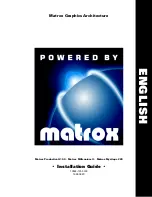
Getting Started with the NI PCIe-8255R
2
ni.com
Refer to the National Instruments catalog, visit
ni.com
, or call the National Instruments office nearest
you for more specific information about these products.
Related Documentation
The following documents contain additional information that you may find helpful:
•
NI PCIe-8255R User Manual
—Contains information about programming options, hardware
functionality, and signal connections.
•
NI Vision Acquisition Software Release Notes
—Contains information about new functionality,
minimum system requirements, and installation instructions for the NI-IMAQ driver software.
•
Measurement & Automation Explorer Help for NI-IMAQdx
—Describes how to configure the
NI-IMAQdx driver software, NI image acquisition devices, and cameras using Measurement &
Automation Explorer (MAX).
•
NI-IMAQdx User Manual
—Contains fundamental programming concepts for the NI-IMAQdx
driver software and terminology for using NI image acquisition devices.
•
LabVIEW Help
—This document contains reference information for the NI-IMAQ I/O shutdown
states VIs, terminal references for the configurable I/O module on the NI-IMAQ I/O device, and
parameter references for the parameters you can set for the NI-IMAQ I/O device in the Read/Write
control. To locate the information, search for
NI-IMAQ I/O
in the
LabVIEW Help
.
Safety Information
Caution
The following paragraphs contain important safety information you
must
follow when
installing and operating the device.
Do
not
operate the device in a manner not specified in the documentation. Misuse of the device may
result in a hazard and may compromise the safety protection built into the device. If the device is
damaged, turn it off and do
not
use it until service-trained personnel can check its safety. If necessary,
return the device to National Instruments for repair.
Keep away from live circuits. Do
not
remove equipment covers or shields unless you are trained to do
so. If signal wires are connected to the device, hazardous voltages can exist even when the equipment is
turned off. To avoid a shock hazard, do
not
perform procedures involving cover or shield removal unless
you are qualified to do so. Disconnect all field power prior to removing covers or shields.
If the device is rated for use with hazardous voltages (>30 V
rms
, 42.4 V
pk
, or 60 V
dc
), it may require a
safety earth-ground connection wire. Refer to the device specifications for maximum voltage ratings.
Because of the danger of introducing additional hazards, do
not
install unauthorized parts or modify the
device. Use the device only with the chassis, modules, accessories, and cables specified in the
installation instructions. All covers and filler panels
must
be installed while operating the device.
Do
not
operate the device in an explosive atmosphere or where flammable gases or fumes may be
present. Operate the device only at or below the pollution degree stated in the specifications. Pollution
consists of any foreign matter—solid, liquid, or gas—that may reduce dielectric strength or surface
resistivity. The following is a description of pollution degrees.
•
Pollution Degree 1—No pollution or only dry, nonconductive pollution occurs. The pollution has
no effect.
•
Pollution Degree 2—Normally only nonconductive pollution occurs. Occasionally, nonconductive
pollution becomes conductive because of condensation.






























